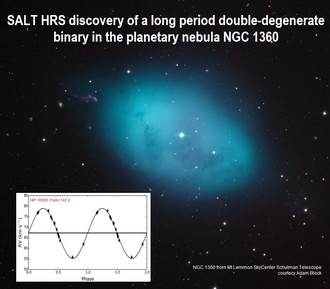
Whether planetary nebulae (PNe) are predominantly the product of binary stellar evolution as some population synthesis models (PSM) suggest remains an open question. Around 50 short period binary central stars (P~1 d) are known, but with only four known with P >10 d our knowledge is severely incomplete. Brent Miszalski (SAAO) with collaborators from NCAC (J. Mikołajewska and K. Iłkiewicz) and KU Leuven report on the first discovery from a systematic SALT HRS survey for long period binary central stars. They find a 142 d orbital period from radial velocities of the central star of NGC 1360 (Robin's Egg Nebula), HIP 16566, infamous for its now disproven kilogauss magnetic field (see Figure). NGC 1360 appears to be the product of common-envelope (CE) evolution with an orbital period at the upper range predicted for post-CE PSM and nebula features similar to post-CE PNe. The most striking feature is a newly-identified ring of low-ionisation structures (LIS) whose inclination matches i = 30+/-10 deg from spatiokinematic modelling of the nebula. Assuming a binary coplanar with the nebula, multi-wavelength observations best fit an evolved WD companion with M = 0.7 Msun, L~50 Lsun and Teff = 115 kK. Nebular kinematics also indicate fallback of CE ejecta occurred in NGC 1360 and simulations show that ~0.2 Msun could have formed into a circumbinary disk. Photoionisation and fragmentation of such a disk, or a post-AGB binary disk that survived into the PN phase, may be central to forming the ring of LIS. Large radial velocity variability detected by lower resolution surveys suggests long period binaries may be much more common than PSM models predict, supporting a 40-50% total binary fraction for PNe.
The paper describing these findings has been submitted for publication in MNRAS (arXiv: 1703.10891).






